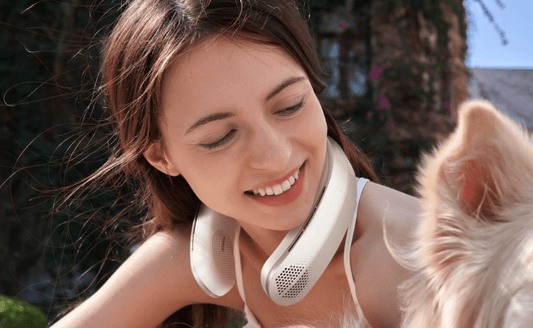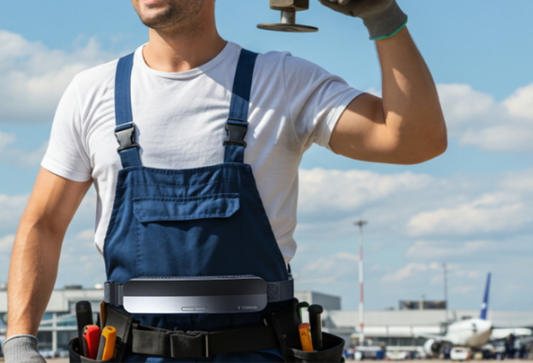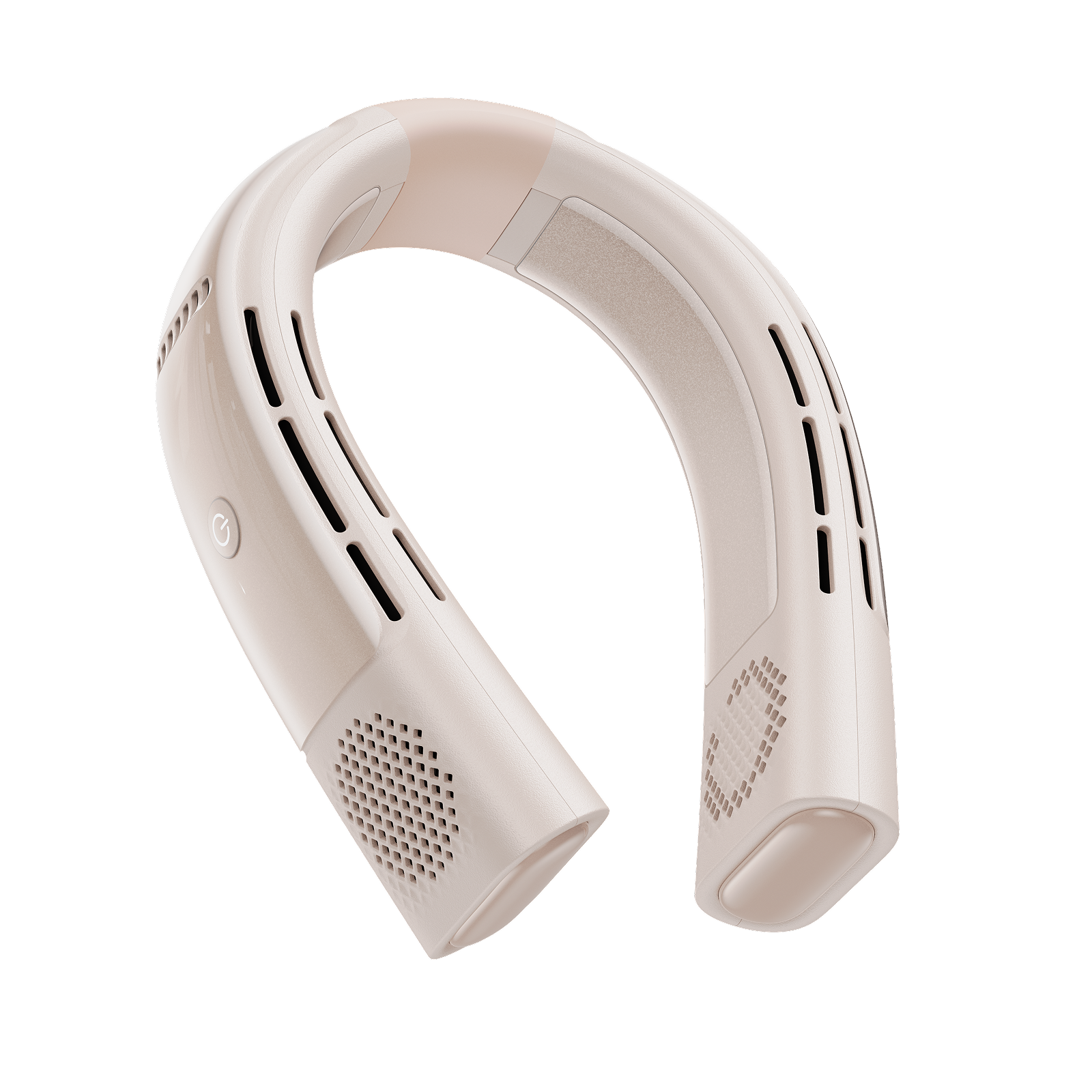Staying cool during summer is no longer just about finding shade or blasting a room air conditioner. Portable personal coolers are becoming more popular, and two of the most talked-about options are neck fans and wearable air conditioners. Both are designed to help you beat the heat, but they work in very different ways.
If you are wondering which one fits your lifestyle better, let’s break it down clearly so you can make the right choice.
What Is a Neck Fan?
A neck fan is a hands-free device that rests comfortably around your neck and blows air upward toward your face and chest. This airflow promotes sweat evaporation, which helps your body cool down naturally. Most neck fans are lightweight, rechargeable, and often bladeless, making them safe for long hair and easy to wear for extended periods.
People use neck fans for commuting, gardening, working in the office, or simply getting relief during light outdoor activities. They are portable, discreet, and provide a steady breeze wherever you go.

What Is a Wearable AC?
A wearable AC takes cooling a step further. Instead of just circulating air, it uses thermoelectric cooling plates to absorb heat directly from your skin. Small built-in fans then release the collected heat, making the cooling more efficient. The sensation feels like applying a cold pack to your neck, but without any dripping water.
This makes wearable ACs highly effective in humid or extreme heat where simple airflow does not feel refreshing. They are heavier and more expensive than neck fans, but they deliver stronger and more consistent cooling power.
Neck Fan vs. Wearable AC: Quick Comparison Table
|
Feature |
Neck Fan |
Wearable AC |
|
Cooling type |
Air circulation |
Thermoelectric cooling |
|
Weight |
Lightweight |
Heavier |
|
Battery life |
3–10+ hours |
2–24 hours |
|
Price range |
30 to 80 dollars |
100 to 200 dollars or more |
|
Noise |
Quiet to moderate |
Quiet with low fan hum |
|
Best for |
Mild heat, commuting, office |
Extreme heat, outdoor work, travel |
Related Reading: Best Portable Neck Fan in 2025
Cooling Effectiveness: Will It Keep You Cool?
Cooling Power of Neck Fans
Neck fans work best in dry or mild heat, where the airflow boosts sweat evaporation and provides natural cooling. In humid climates, the effect is weaker because moisture in the air slows evaporation. Even so, many people find neck fans helpful on crowded trains, in stuffy offices, or while gardening and walking outside.
Tip: Lightly wet your neck or temples before wearing the fan. The airflow will enhance evaporation and make the cooling feel stronger.
Cooling Power of Wearable ACs
Wearable ACs shine in situations where neck fans struggle. They provide immediate cooling relief even in sticky, humid air, since they physically draw heat away from your skin. The effect is localized, so it won’t cool your entire body, but it can still make a significant difference in comfort during extreme heat.
Tip: Move the device slightly every so often or use it in intervals to prevent your skin from feeling numb.
Related Reading: Best Portable Outdoor Air Conditioner for 2025
Battery Life: How Long Can You Use It?
Neck Fan Battery Life
Neck fans typically run between 3 and 10 hours on a single charge, depending on the airflow speed you select. Many models now feature 4000 mAh batteries, fast USB-C charging, and smart power management to extend runtime. With optimized airflow engineering—like multi-fan designs and efficient motor systems—lower-to-medium settings often provide enough power for a full workday or a longer commute. Among them, the TORRAS COOLiTE Neck Fan stands out with a bold quad-fan boost, 360° airflow, and up to 13 hours of cooling in a lightweight 290 g design, making it ideal for active, on-the-go lifestyles.
Tip: Stick to low or medium speeds indoors to conserve energy, and carry a compact power bank when you’re out and about to ensure uninterrupted cooling.
Wearable AC Battery Life
Because they rely on advanced cooling plates and internal fans, wearable air conditioners naturally consume more energy than standard neck fans. However, modern designs now feature larger-capacity batteries (often 5000–6000mAh) and smart power management systems, allowing them to last much longer than older generations. Depending on the settings, you can expect anywhere from 2–3 hours on maximum cooling to 15–28 hours on eco or auto modes, which is more than enough for commuting, travel, or even a full work shift outdoors.
Tip: Use maximum cooling in short bursts when exposed to direct sun or high heat, then switch back to eco mode for steady comfort and extended battery life.

Comfort: Can You Wear It for Hours?
Neck Fan Comfort
Because they are light, neck fans are comfortable to wear for hours. However, the airflow may cause dryness in your eyes or irritation if directed too high. Adjustable airflow models solve much of this problem.
Tip: Angle the vents toward your neck and chest instead of your face for a more natural cooling experience.
Wearable AC Comfort
Wearable ACs are heavier due to their cooling plates and fans. Some users notice heat buildup near the collar area where warm air is released. This may feel uncomfortable for those who wear collared shirts or backpacks.
Tip: Keep your collar open or choose breathable clothing to help hot air escape.
Noise: Will It Disturb You?
Neck Fan Noise
At higher speeds, neck fans produce a noticeable airflow sound similar to a small desk fan. Outdoors this is rarely a problem, but in quiet places like libraries it may feel distracting.
Tip: Use medium settings in offices or classrooms for a balance of cooling and quiet operation.
Wearable AC Noise
The cooling plates are silent, but the exhaust fans create a soft hum. Premium models minimize this sound, especially in eco or auto modes, making them suitable even for shared indoor spaces.
Tip: Let the auto mode adjust fan speed when indoors so the device stays quieter.
Safety and Practical Use
Neck Fan Safety
Cheaper neck fans sometimes have exposed blades that can catch long hair. Bladeless or mesh-covered designs are safer and more comfortable for daily use.
Tip: If you have long hair, tie it back or choose a bladeless option such as the TORRAS COOLiTE Neck Fan for worry-free cooling.
Wearable AC Safety
Direct cold contact for long periods may irritate sensitive skin. Prolonged use on maximum cooling can cause discomfort or temporary redness.
Tip: Take breaks or use fabric pads between your skin and the cooling plate to protect sensitive areas.
Lifestyle Fit: Which Situations Suit Each?
Commuting and Office
For commuting or office work, neck fans are discreet and lightweight. They run quietly and last long enough for a typical day. Wearable ACs provide stronger relief but may feel bulky in professional settings.
Outdoor Work and Travel
For outdoor workers and frequent travelers, wearable ACs are often the better choice. They perform well in high heat and humidity where fans alone fall short. Neck fans still help if you are moving often, such as walking, biking, or sightseeing.
Fitness and Sports
Neck fans are the go-to for runners, cyclists, and gym-goers because they stay secure and provide constant airflow during movement. Wearable ACs are better for stationary activities like watching a game, camping, or sitting outdoors.
Durability and Maintenance
Neck fans and wearable ACs both need basic care to stay effective. Neck fans may collect dust or hair in the motor, while wearable ACs require regular cleaning of cooling plates and vents.
Tip: Wipe sweat and dust away with a soft cloth, keep the device dry when not in use, and store it in a safe place. For higher-priced wearable ACs, check the warranty so you’re covered if anything goes wrong.

Cost and Value
Neck Fan Cost
Neck fans are budget-friendly, usually priced between 30 and 80 dollars. They are a smart choice if you want simple, reliable cooling without spending much.
Wearable AC Cost
Wearable ACs cost more, typically 100 to 200 dollars or higher. The investment makes sense if you live in hot, humid areas, work outdoors often, or want the strongest portable cooling available.
Tips to Maximize Your Cooler
-
Stay hydrated so your body can regulate temperature more effectively.
-
Wear lightweight, breathable fabrics to boost cooling efficiency.
-
Take breaks in the shade when possible, especially outdoors.
-
Clean your device regularly to maintain airflow and extend its lifespan.
Frequently Asked Questions
Can I use these while exercising?
Yes. Neck fans are better for active use like running or cycling, while wearable ACs are best for stationary activities.
Do they work in humid weather?
Neck fans are less effective in humidity, while wearable ACs continue to deliver consistent cooling.
Are they safe for sensitive skin?
Yes, but avoid continuous direct contact with cooling plates. Use fabric pads if your skin is sensitive.
Can these replace air conditioning?
No. They provide personal comfort, not room-wide cooling. Think of them as portable companions.
Do they help with hot flashes or heat sensitivity?
Yes. Many users find relief for hot flashes and heat intolerance. The right choice depends on whether you prefer airflow or direct cooling.
Conclusion
Neck fans and wearable ACs both have their place. A neck fan is light, affordable, and perfect for everyday use in mild heat. A wearable AC delivers stronger cooling and is worth the higher price if you deal with extreme heat or humidity.
The best choice depends on your lifestyle. If you want something portable and simple, a neck fan will keep you comfortable in most situations. If you often face harsh heat or spend long hours outdoors, a wearable AC might be the smarter investment.






